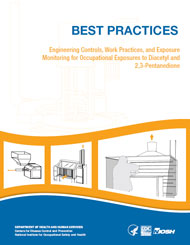Best Practices: Engineering Controls, Work Practices, and Exposure Monitoring for Occupational Exposures to Diacetyl and 2,3-Pentanedione
July 2015
DHHS (NIOSH) Publication Number 2015-197

Workers who handle diacetyl or work in areas where diacetyl exposure occurs are at risk of developing severe lung disease if their exposures are not properly controlled. The National Institute for Occupational Safety and Health (NIOSH) has developed guidance in a variety of areas to reduce workers’ exposures to diacetyl through engineering controls, best work practices, and techniques for monitoring airborne diacetyl exposures. Although these guidelines emphasize diacetyl, they can be applied to reduce exposures to diacetyl substitutes such as 2,3-pentanedione and other alpha-diketones.
Page last reviewed: July 13, 2015
Content source: National Institute for Occupational Safety and Health
